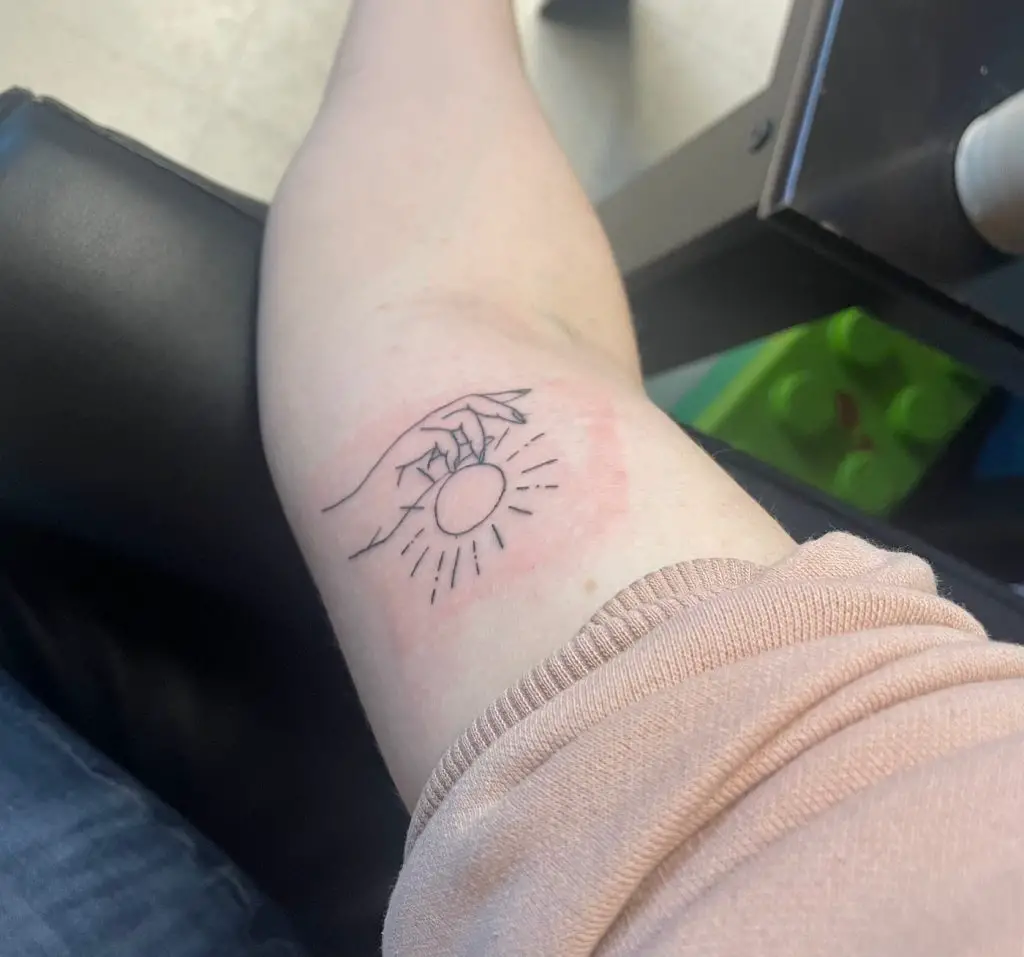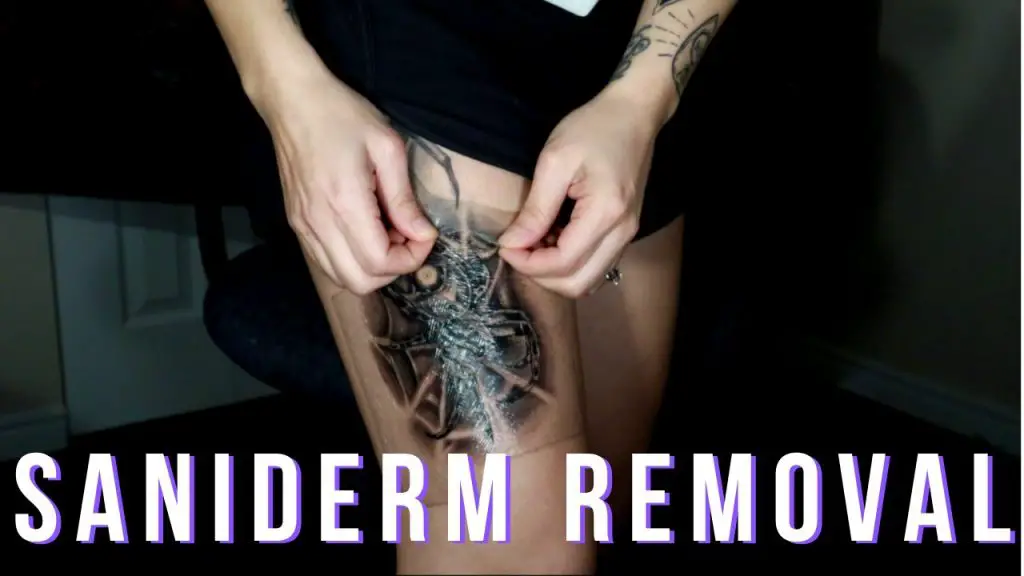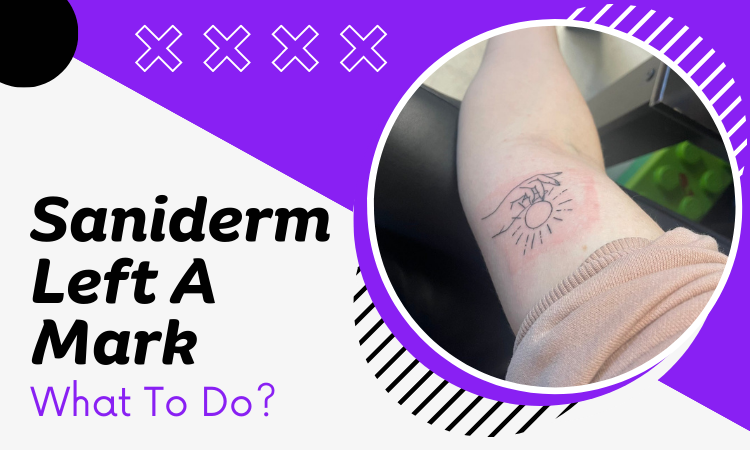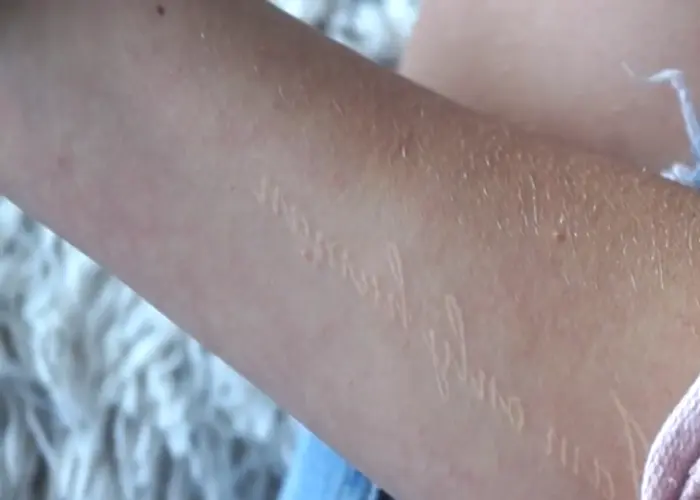Saniderm Left A Mark- What To Do?
Saniderm is a brand that produces transparent, adhesive film dressings that are designed to protect and heal fresh tattoos. While the product has gained popularity, there have been reports of individuals experiencing adverse reactions to the product, leaving a mark on their skin. We totally understand if you’re struggling with the same issue.
So, what can you do when Seniderm left a mark?
There could be several reasons behind a mark left by Seniderm. It could be due to the strength of the adhesive, prolonged use of the bandage, or skin sensitivity. To tackle this issue, you can use coconut oil, rubbing alcohol or adhesive remover after cleaning the area. Try not to scratch the spot and keep it moisturized.
But that’s not all. There’s much more that you need to know. This article has all the answers you need.
So, what are you waiting for? Let’s begin!
Saniderm Left A Mark- What Does It Mean?

Saniderm is a type of transparent adhesive bandage that is commonly used to cover and protect tattoos during the healing process. When someone says “Saniderm left a mark,” it could mean a few different things:
Saniderm Left Mark on The Skin:
It could mean that the adhesive from the Saniderm bandage left a residue or mark on the skin after the bandage was removed. This can happen if the bandage was left on for too long, or if the skin was particularly sensitive to the adhesive.
Saniderm Caused Damage to The Skin:
It could mean that the Saniderm bandage caused irritation or damage to the skin. This can happen if the bandage was too tight or if the skin reacted poorly to the adhesive.
Tattoo Has Blemish After Saniderm Removal:
It could mean that the tattoo itself has a visible mark or blemish after the Saniderm was removed. This could happen if the Saniderm was not applied correctly or if it was left on for too long, causing the tattoo to heal improperly.
Overall, while Saniderm can be an effective way to protect tattoos during the healing process, it’s important to use it properly. Also, follow the instructions carefully to avoid any unwanted marks or damage to the skin.
What causes Saniderm to leave a mark?
While it is generally considered an effective way to safeguard tattoos during the healing process, some individuals have reported issues with Saniderm leaving a mark on their skin after use. Here, we will explore the different reasons why Saniderm may leave a mark on the skin and the associated risks.
Strength of The Adhesive:
One of the primary reasons why Saniderm may leave a mark on the skin is due to the strength of the adhesive. The adhesive is intended to be strong enough to keep the bandage in place for extended periods. But it may be too strong for some people.
In some cases, the adhesive can cause residue or marks to remain on the skin even after the bandage has been removed. This issue may be exacerbated in individuals with sensitive skin or in areas where the skin is more delicate, such as the neck or inner arm.
Prolonged Use of The Bandage:
Another reason why Saniderm may leave a mark on the skin is if the bandage is left on for an extended period. Saniderm is designed to be worn for a specific amount of time. It typically ranges from 24-72 hours depending on the size and location of the tattoo.
If the bandage is left on for too long, it can cause problems such as the adhesive becoming too bonded to the skin or skin irritation due to prolonged contact with the bandage. This may result in marks or residue being left on the skin after removal.
Skin Sensitivity to The Adhesive:
Skin sensitivity to the adhesive is yet another reason why Saniderm may leave a mark on the skin. Saniderm is generally considered safe for most skin types, but some individuals may have an allergic reaction or sensitivity to the adhesive. This can lead to skin issues such as redness, itching, or even blisters
In some cases, may result in marks or residue being left on the skin. So, Saniderm can be an effective method for protecting tattoos during the healing process. But, it can potentially leave a mark on the skin due to a variety of factors.
To minimize the risk of these issues, it is recommended to follow the instructions carefully. Consulting with a professional tattoo artist or dermatologist is recommended if any concerns arise. Sometimes skin sensitivity can occur from the ink as well. SO, it’s better to use good quality inks like the Kuro sumi ink.
How to prevent Saniderm from leaving a mark
Fortunately, there are steps you can take to help prevent Saniderm from leaving a mark on your skin. Follow these:
- Follow Instructions Carefully: First and foremost, it is important to carefully follow the instructions provided with your Saniderm bandage. This includes ensuring that your skin is clean and dry before applying the bandage. Properly applying and removing the bandage within the recommended time frame is included as well.
By following the instructions carefully, you can help ensure that the bandage works as intended and reduces the likelihood of leaving a mark on your skin.
- Choose the Right Size and Shape: It is also important to choose the right size and shape of Saniderm bandage for your tattoo. Using a bandage that is too small can lead to the adhesive coming into contact with unprotected skin.
Similarly, using a bandage that is too large can result in wrinkles or folds that may cause irritation or marks. By selecting the appropriate size and shape for your tattoo, you can help ensure that the bandage stays in place and minimizes the risk of leaving a mark on your skin.
- Avoid Touching or Scratching: While wearing Saniderm, it is important to avoid touching or scratching the bandage, as this can cause it to come loose or become misaligned. This can lead to issues such as the adhesive coming into contact with unprotected skin or the bandage becoming wrinkled, which can increase the likelihood of leaving a mark on your skin.
If you do need to adjust the bandage, be sure to wash your hands thoroughly beforehand and use a gentle touch to avoid causing damage to the bandage or your skin.
- Remove the Bandage Carefully: When it is time to remove the Saniderm bandage, it is important to do so carefully and slowly to minimize the risk of leaving a mark on your skin. Start by gently lifting one corner of the bandage and peeling it back slowly, working your way around the entire bandage.
If you encounter any resistance or discomfort, stop and soak the bandage in warm water to help loosen the adhesive before trying again. By taking your time and being gentle when removing the bandage, you can help ensure that it comes off smoothly and without leaving any unwanted marks or residue.
- Moisturize the Skin: After removing the Saniderm bandage, it is important to moisturize the skin to help promote proper healing and reduce the risk of marks or scarring. Use a gentle, fragrance-free lotion or ointment to keep the skin hydrated and to help prevent any dryness or itching that could lead to scratching or irritation.
Be sure to avoid applying any lotion or ointment to the tattoo itself until it has fully healed, as this can interfere with the healing process and increase the risk of infection. Also, working out after just getting a tgattoo can be a bad idea.
It is important to take steps to prevent it from leaving a mark on your skin. By following the instructions carefully, you can help ensure that your tattoo heals properly and without any unwanted marks or residue.

What to do if Saniderm leaves a mark
There are several steps you can take to help remove or reduce the appearance of the mark. Follow these steps if Saniderm leaves a mark on your skin after tattoo healing:
- Clean the area: Before attempting any removal methods, it’s important to clean the affected area with soap and warm water to remove any debris or residue from the Saniderm bandage. You should wait at least 24 hours before washing your new tattoo with water and soap.
After getting a new tattoo, your skin needs time to heal and form a protective layer of scabbing. During this time, it’s important to avoid exposing your tattoo to excess moisture. Why? Because this can slow down the healing process and increase the risk of infection.
- Apply coconut oil: Coconut oil is known for its moisturizing and healing properties, and can help to soften and lift the adhesive residue left by Saniderm. Apply a small amount of coconut oil to the affected area and massage it gently in circular motions for a few minutes. Let it sit for a few minutes before wiping away with a soft cloth.
- Use rubbing alcohol: Rubbing alcohol is an effective solvent that can break down and dissolve the adhesive residue. Dampen a cotton ball with rubbing alcohol and gently rub the affected area in circular motions until the residue lifts off. Be sure to rinse the area thoroughly with warm water and pat dry.
- Try adhesive remover: If the coconut oil and rubbing alcohol methods do not work, consider using an adhesive remover specifically designed for medical bandages. These products can be found at most drug stores and typically come in the form of a spray or wipe. Follow the instructions carefully and be sure to rinse the area thoroughly with warm water and pat dry.
- Apply a healing ointment: Apply a thin layer of a healing ointment, such as Aquaphor or A&D ointment, to the affected area. This can help soothe the skin and promote healing.
- Avoid picking or scratching: It can be tempting to pick or scratch at the mark left by Saniderm, but this can make the situation worse by causing further irritation and potentially leading to infection. Try to avoid touching the area as much as possible.
- Consult a professional: If the mark persists or if you experience any adverse reactions, it’s best to consult a dermatologist or tattoo artist for further advice. They may be able to recommend additional removal methods or provide medical treatment if necessary.
It’s important to note that while these methods may help to remove or reduce the appearance of Saniderm marks, prevention is always the best course of action. Be sure to follow the instructions carefully when using Saniderm. And, if you have any concerns about the healing process or tattoo aftercare, consult with your tattoo artist or a medical professional.
Tips for helping your skin heal after using Saniderm
It’s important to take proper care of your skin after using Saniderm to help it heal fully and minimize the risk of any long-term marks or scarring. Here are some tips for helping your skin heal after using Saniderm:
- Keep the area clean: While Saniderm can help to protect your tattoo during the initial healing phase, it’s important to keep the area clean once the bandage is removed. Use a gentle, unscented soap and warm water to clean the area twice a day, and pat it dry with a clean towel. Avoid rubbing the area, as this can cause irritation or damage to the healing skin or yellow skin around the tattoo.
- Moisturize regularly: Keeping the skin moisturized can help to prevent it from becoming dry, itchy, or irritated after using Saniderm. Use a gentle, fragrance-free moisturizer and apply it to the area several times a day, or as needed. Be sure to choose a moisturizer that is specifically formulated for sensitive skin, as some ingredients can cause irritation or allergic reactions.
- Avoid tight clothing: After using Saniderm, it’s important to avoid wearing tight or restrictive clothing over the tattooed area. This can cause friction and irritation, which can slow down the healing process and increase the risk of scarring. Wear loose, comfortable clothing that allows the skin to breathe and heal naturally.
- Avoid sun exposure: Exposing the tattooed area to the sun can cause damage and delay the healing process. After using Saniderm, avoid direct sunlight and wear protective clothing, such as long sleeves or a hat, to shield the area from the sun’s rays. If you must be outside, use a broad-spectrum sunscreen with an SPF of 30 or higher and reapply it regularly.
- Don’t scratch or pick at the area: It can be tempting to scratch or pick at the healing skin after using Saniderm, but this can cause damage and increase the risk of scarring. Avoid touching the area with dirty hands and don’t scratch or pick at any scabs or flakes that may form. Let the skin heal naturally and avoid interfering with the process.
By following these tips, you can help your skin heal fully and reduce the risk of any long-term marks or scarring after using Saniderm. If you have any concerns, such as excessive redness, swelling, or discharge, be sure to consult with your tattoo artist or a healthcare professional.
Frequently Asked Questions (FAQs):
Could Saniderm cause harm to a tattoo?
The adhesive used by Saniderm is designed not to stick to the weeping area of a new tattoo, preventing the risk of damage or ink being pulled out. There have been reports that suggest using Saniderm results in tattoos retaining their vibrant colors better than when other aftercare products are used.
What causes the blurry appearance of my tattoo when covered with Saniderm?
During the first day or so after getting a tattoo, it is common for it to release some ink, blood or other fluids. When Saniderm is applied, these fluids may become trapped underneath, leading to a blurry or opaque appearance. It’s important to note that this is a normal part of the healing process and does not indicate any problems with the tattoo or the use of Saniderm.
When is the appropriate time to remove Saniderm?
Saniderm should be removed after 3-4 days by gently stretching it from each side under warm running water. This is done to prevent the adhesive from disrupting the tattoo and removing any ink along with it. Peeling it off like a Band-Aid is not recommended. By stretching it, the bandage will come off easily without causing any damage to the tattoo.
End Note
That’s all for today. Hopefully all your confusions were cleared regarding what to do when Seniderm left a mark.
We will be back soon with more interesting topics. Till then, goodbye!






